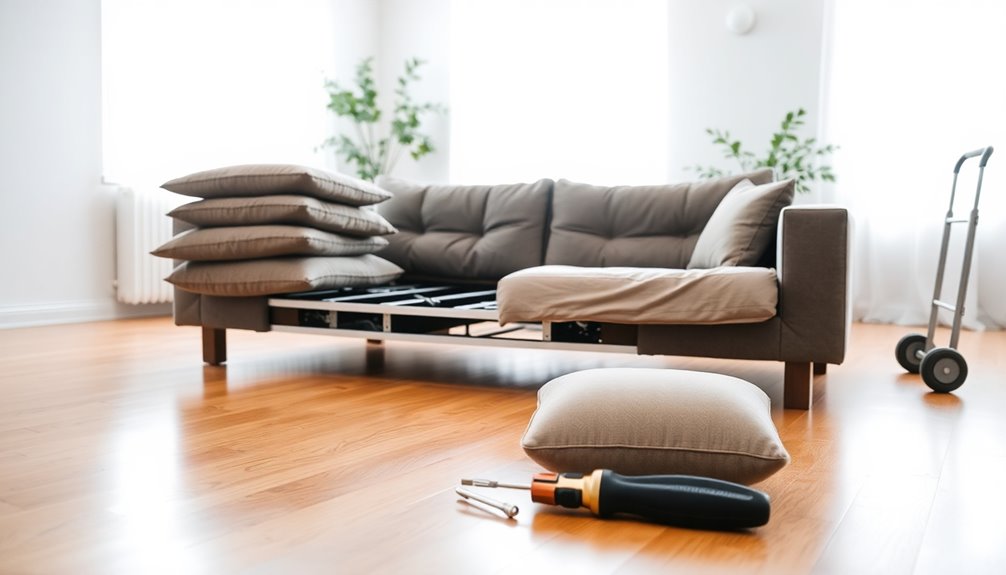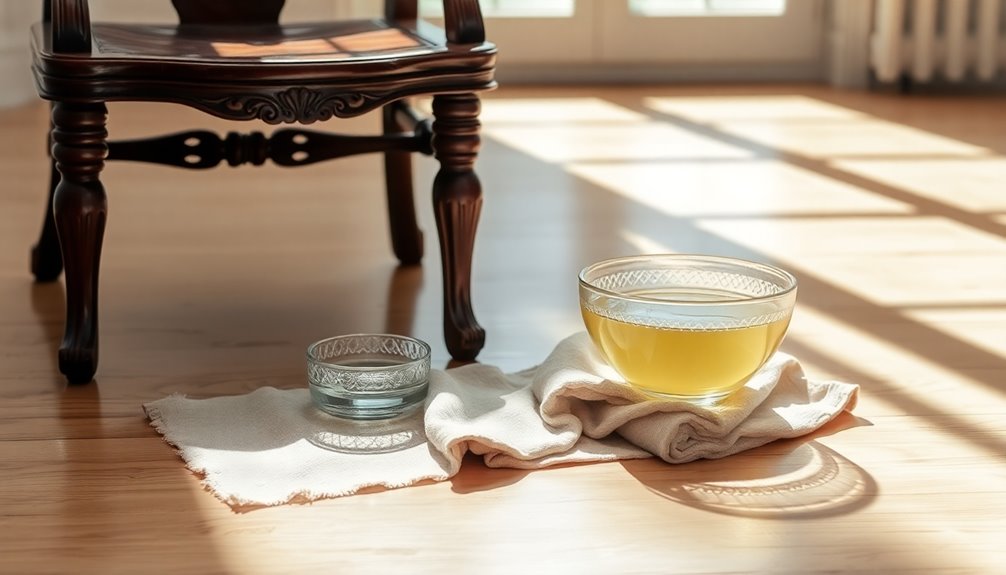To take apart a sofa bed for moving, start by removing the cushions. Next, check for any loose screws or bolts and tighten them. Then, locate the mechanism that folds the bed out and carefully release it. If there’s a mattress, remove it and store it in a protective bag. Disassemble the frame by unscrewing parts, and keep all screws in labeled bags for easy reassembly. Lastly, protect the components with blankets or covers during transport. With these steps, you’ll be ready for a smooth move, and there’s more helpful info around the corner! When you’re ready to transport the disassembled parts, it’s essential to use proper lifting techniques to move heavy furniture safely. Consider enlisting the help of friends or using a dolly to prevent injury and make the process easier. Once you arrive at your new location, follow the reverse order of disassembly for a smooth reassembly, ensuring that everything is secure and in place for optimal safety and comfort.
Key Takeaways
- Remove cushions and any removable covers to lighten the load and protect fabric during the move.
- Disconnect the mattress and store it separately in a breathable bag to prevent mold.
- Use a suitable wrench or screwdriver to unscrew and detach the frame components carefully.
- Organize screws and small parts in labeled bags for easy reassembly at the new location.
- Wrap the disassembled parts with furniture covers or blankets to protect against scratches and dust during transport.
Introduction
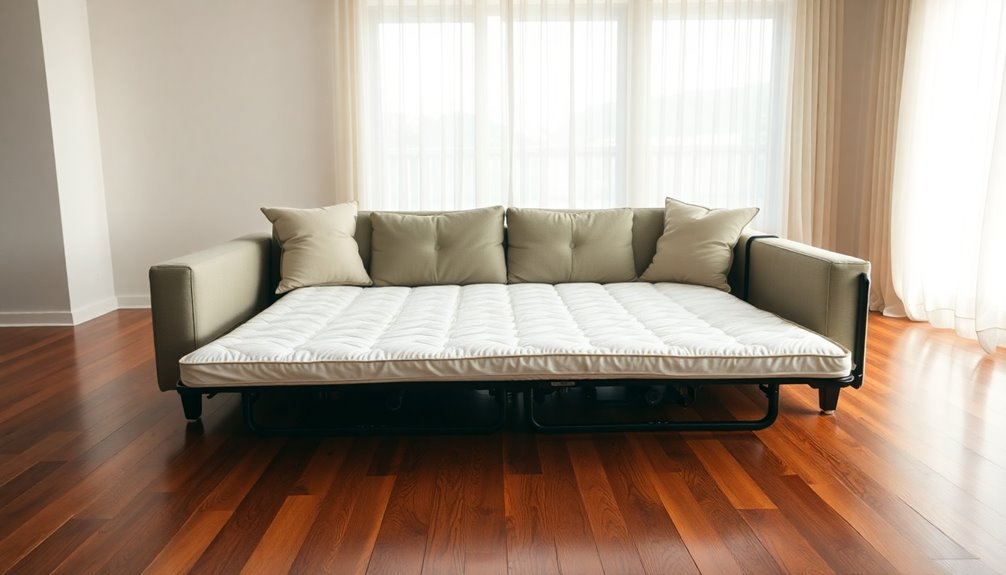
When it comes to keeping your sofa bed in top shape, routine fabric conditioning is key. You'll also want to learn fabric-specific cleaning techniques and how to treat pesky wine stains effectively. By mastering these skills, you can ensure your sofa bed not only looks great but lasts longer.
Routine Fabric Conditioning
To keep your sofa bed looking fresh and vibrant, routine fabric conditioning is essential. Regular fabric conditioning helps maintain the appearance and longevity of your sofa bed upholstery by preventing fading and wear from daily use. Using a fabric conditioner specifically designed for upholstery enhances the softness and texture of the fabric, ensuring a comfortable seating experience.
It's best to condition the fabric every 3 to 6 months, depending on how often you use the sofa bed. This practice keeps the fibers in optimal condition and prevents deterioration over time. Additionally, regular conditioning provides a protective layer against stains and spills, making it easier to clean and maintain your sofa bed.
Before fully applying the fabric conditioner, always test it on a small, inconspicuous area first. This ensures compatibility with your specific upholstery type, avoiding any potential damage. By taking these steps, you'll not only preserve the beauty of your sofa bed but also enhance its durability, giving you peace of mind as you enjoy your living space.
Fabric-Specific Cleaning Techniques
Choosing the right cleaning technique is crucial for maintaining your sofa bed's fabric. Different fabrics require tailored cleaning methods, so always check the care label for specific instructions. You'll find labels like "W" for water-based solutions, "S" for solvent-based cleaners, "WS" for either option, or "X," indicating professional cleaning only.
For synthetic fabrics, water-based cleaning solutions work well, while natural fibers like leather and silk benefit from solvent-based cleaners. When addressing upholstery stains, act quickly: blot the area with a clean, dry cloth and avoid rubbing, as this can spread the stain or damage the fabric.
A vacuum with an upholstery attachment is your best friend for routine maintenance. Regularly removing dust and debris helps preserve the fabric's appearance and extends its lifespan. Before applying any cleaning solution, test it on a hidden area to ensure it won't cause discoloration or damage.
Treating Wine Stains Effectively
Even with the best care, accidents can happen, and wine stains are among the most challenging to tackle on your sofa bed. When you notice a spill, act quickly: blot the area with a clean cloth to absorb the excess liquid before it sets. Next, mix equal parts white wine and club soda and apply it directly to the stain. This mixture helps neutralize the red wine.
If the stain is stubborn, create a paste using baking soda and water. Apply it to the affected area and let it sit for about 30 minutes before rinsing with cold water. Always remember to test any cleaning solution on a hidden area of the fabric first to avoid discoloration or damage.
If your sofa bed has delicate fabric, consider using a specialized upholstery cleaner designed for wine stains to protect the material. And if the situation calls for a thorough cleaning, don't forget to remove the mattress and check under it for any hidden stains. Also, when disassembling your sofa bed, keep an eye out for screws that might need to be removed for easier access. Additionally, understanding the importance of user control over data privacy can help you make informed decisions about cleaning products you choose to use.
Avoiding Direct Sunlight Exposure
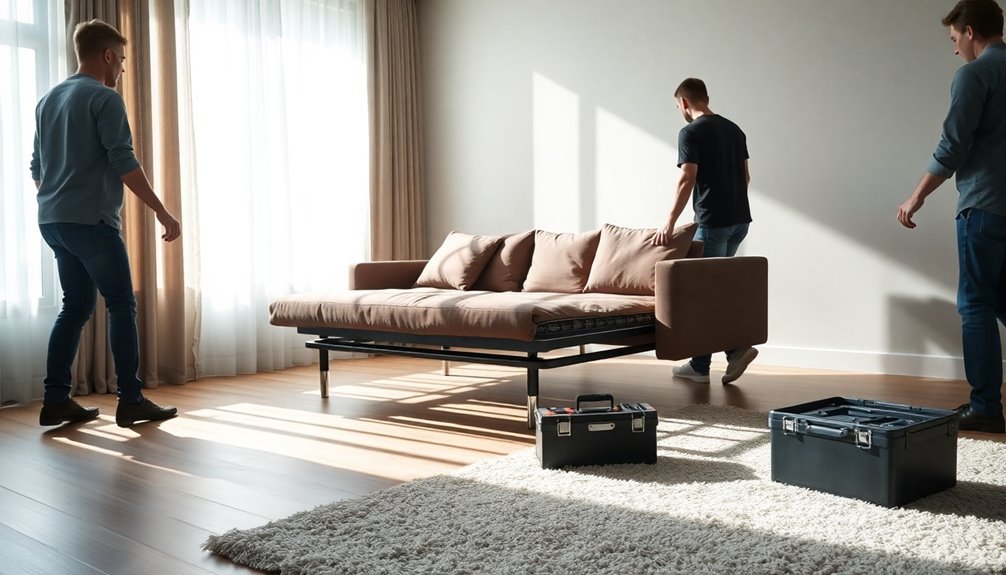
When you're preparing to move your sofa bed, protecting it from direct sunlight is key to maintaining its quality. Consider using scratch-resistant fabrics or durable covers that can withstand the elements during transport. Also, investing in protective furniture covers designed to block UV rays can save your upholstery from fading or damage.
Using Scratch-Resistant Fabrics
Many homeowners find that using scratch-resistant fabrics, like microfiber and polyester blends, is a smart choice for sofa beds, especially in busy living spaces. These materials offer excellent durability against wear and tear, making them ideal for high-traffic areas. When you're preparing for the disassembly process, consider how these fabrics can withstand daily use while maintaining their appearance.
To keep your sofa bed looking new, it's crucial to avoid direct sunlight exposure. Position your sofa bed away from windows, or use UV-filtering window treatments to prevent fading and deterioration. Regularly cleaning your scratch-resistant fabrics with a soft cloth or vacuum will help prevent dirt buildup and prolong their lifespan.
Many scratch-resistant fabrics come with protective coatings that repel stains and liquids, making maintenance easier compared to untreated materials. For added aesthetic appeal, choosing lighter colors can help minimize the visibility of scratches and wear, ensuring your sofa bed remains visually pleasing over time. By selecting the right scratch-resistant fabrics and protecting them from sunlight, you can enjoy a durable and attractive sofa bed for years to come. Additionally, proper care of these fabrics can enhance their longevity, aligning with the principle that proper storage maintains quality in various household items.
Choosing Durable Fabric Covers
Choosing durable fabric covers for your sofa bed is essential for maintaining its appearance and longevity. When selecting your covers, opt for materials like polyester or microfibers, which are known for their resilience against wear and fading. However, even the toughest fabrics need protection from harmful UV rays. Avoiding direct sunlight exposure is crucial, as these rays can degrade and discolor your fabric over time, shortening its lifespan.
Investing in UV-resistant fabric covers is a smart move. These covers are designed to withstand sun exposure, prolonging the aesthetic appeal and functionality of your sofa bed. You should also consider regularly rotating and repositioning your sofa bed. This practice helps minimize the impact of sunlight on specific areas, preventing uneven fading and damage.
To further protect your sofa bed, utilize window treatments such as blinds or curtains. These can effectively shield your sofa bed from harmful sunlight, preserving the integrity of its fabric covers. By taking these steps, you'll ensure your sofa bed remains a beautiful and functional piece of furniture for years to come.
Using Protective Furniture Covers
Protecting your sofa bed during a move is just as important as selecting durable fabric covers. Using protective furniture covers can significantly prevent scratches and damage to the upholstery while in transit. Make sure the covers you choose are breathable to avoid moisture buildup, which can lead to mold or mildew forming on your sofa bed.
When selecting covers, opt for ones that fit snugly around the entire sofa bed, including the arms and legs. This will help keep out dust and dirt, ensuring your furniture stays clean. One crucial aspect to remember is to avoid exposing the covered sofa bed to direct sunlight. UV rays can fade fabrics and damage materials over time, compromising the integrity of your sofa bed.
Consider using padded protective furniture covers for added protection, especially if your sofa bed features delicate surfaces like leather or intricate fabric. These padded covers provide an extra layer of defense against potential impact during the move. By taking these precautions, you can safeguard your sofa bed and ensure it arrives at your new location in excellent condition, ready for use.
Regularly Tighten Loose Joints
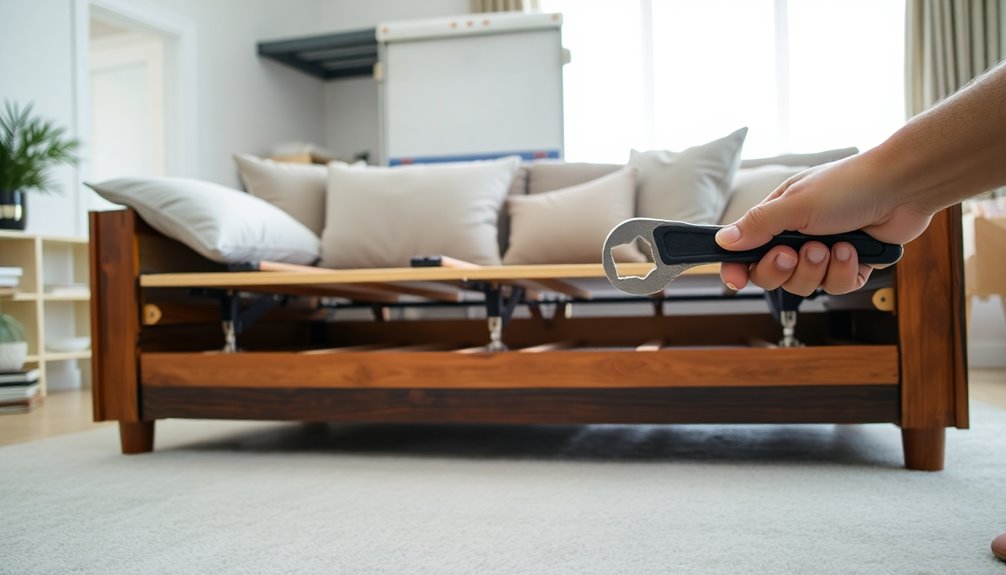
To keep your sofa bed safe and functional, regularly check for loose joints. If you ignore these stability concerns, you might face issues during disassembly or reassembly. Plus, addressing joint stability can make it easier to incorporate leather repair techniques and cushion fluffing methods down the line.
Joint Stability Concerns
While you might enjoy the comfort of your sofa bed, it's crucial to regularly inspect and tighten loose joints to maintain its stability. Joint stability concerns can lead to a frustrating experience if your furniture starts wobbling or even collapses under pressure. Make it a habit to check the screws and bolts during your routine maintenance checks every six months.
When you're addressing these issues, use a torque wrench to ensure fasteners are tightened to the manufacturer's specifications. Remember, over-tightening can cause damage, while under-tightening could compromise safety. Pay special attention to the pivot points of the sleeper mechanism, as these areas endure the most stress when switching between sofa and bed modes.
If you notice any loose joints, consider applying wood glue to strengthen the connection, especially in wooden frames. This added support can enhance joint stability and help you avoid future issues. By staying on top of your furniture assembly and maintenance, you can ensure your sofa bed remains a safe and comfortable option for lounging or sleeping, allowing you to enjoy it without worry. Additionally, maintaining joint stability is crucial for ensuring the longevity of your furniture.
Leather Repair Techniques
Leather sofa beds not only offer style but also require regular maintenance to keep them looking their best. One essential maintenance task is to regularly inspect and tighten any loose joints to maintain structural integrity. Start by checking the connections where the frame meets, especially around stress points like the fold of the bed frame.
Use a suitable wrench or screwdriver to securely fasten any bolts or screws you find loose. This will help prevent further damage or wear to your sofa bed. After tightening the joints, it's a good idea to apply a leather conditioner to the surrounding areas. This keeps the leather supple and helps prevent cracks that can develop over time.
Keep a record of the condition of the joints and any repairs you make. Documenting this information will aid you in tracking maintenance and ensuring the longevity of your leather sofa bed. By staying on top of these simple repair techniques, you'll not only preserve the beauty of your furniture but also extend its life, making sure it remains a stylish and functional piece in your home.
Cushion Fluffing Techniques
Cushion maintenance is crucial for keeping your sofa bed inviting and comfortable. Regularly fluffing cushions helps maintain their shape and comfort, ensuring a welcoming seating area for guests. To effectively fluff your cushions, take them out of the sofa bed and give them a good shake or beat. This redistributes the filling evenly, allowing the cushions to regain their form.
In addition to fluffing techniques, don't overlook the importance of tightening loose joints in the sofa bed frame. Use a wrench or screwdriver to secure any bolts or screws that may have loosened over time. Make it a routine to check these joints every few months; this simple task can prevent further damage and prolong the lifespan of your sofa bed.
Investing in high-quality cushion fillers can also enhance the fluffiness and support of your cushions. With the right materials, regular fluffing becomes even more effective, making it easier to maintain their shape. By combining cushion fluffing techniques with routine maintenance of the frame, you'll ensure your sofa bed remains a comfortable spot for relaxation and gatherings.
Personalized Cushion Options
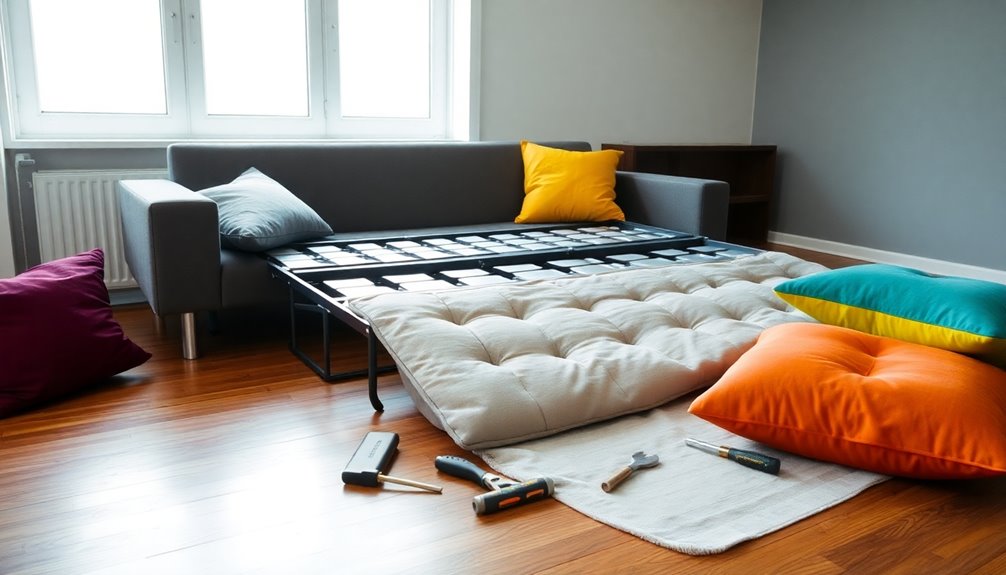
Transforming your sofa bed into a personalized oasis starts with choosing the right cushions. Personalized cushion options let you select fabrics, colors, and patterns that align with your home's unique style. Whether you prefer bold prints or subtle hues, you'll find custom cushions that enhance your space's aesthetic.
You can also customize the cushion fill to suit your comfort needs. Options like memory foam, down, or polyester fiber offer varying levels of support, ensuring you enjoy your sofa bed to the fullest. If you have specific ergonomic requirements, custom cushions can be designed to promote better posture, reducing discomfort during use.
Don't overlook practicality, either. Many manufacturers provide removable and washable cushion covers, making maintenance a breeze and prolonging the life of your sofa bed. This flexibility allows you to refresh your look as trends change or simply as your tastes evolve.
With personalized cushion options, you can truly make your sofa bed a reflection of your personality and comfort preferences, ensuring it's not just a functional piece, but a stylish focal point in your living space. Additionally, choosing high-quality materials can enhance durability and ensure your cushions maintain their shape over time, contributing to an overall energy-efficient option for your living environment.
Seasonal Storage Recommendations
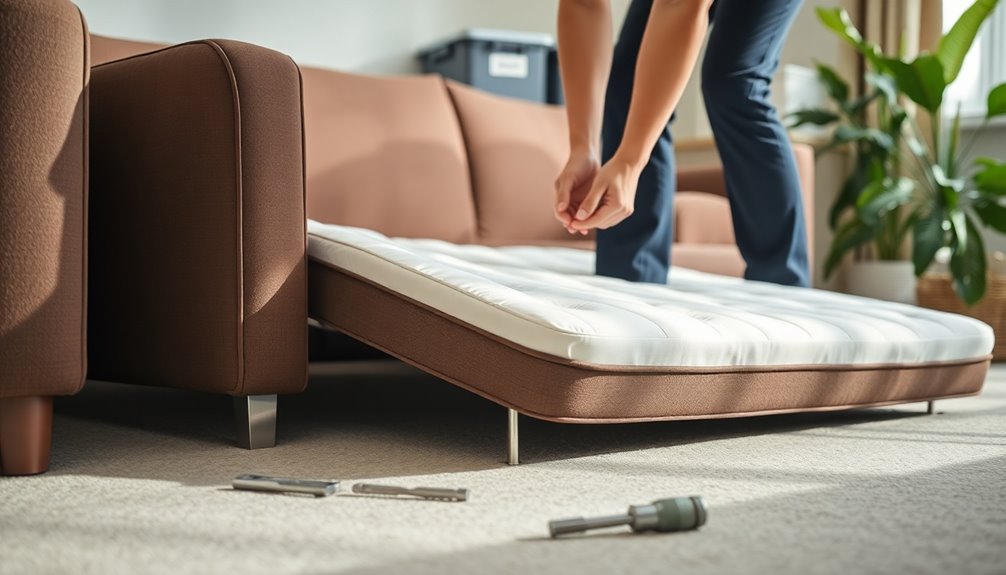
When it comes to storing your sofa bed for the season, proper preparation is key to keeping it in great shape. Start by completely disassembling the sofa bed, removing any retaining bolts or screws, and cleaning all components to prevent damage from dust and moisture. Use furniture covers or blankets for added protection against scratches and dust while it sits in a climate-controlled environment.
Don't forget about the mattress; store it separately in a breathable mattress bag to avoid mold and odors. This keeps it fresh for when you need it again. As you disassemble, keep all screws, bolts, and small parts organized in labeled bags or containers. This will streamline reassembly when the time comes to put the sofa bed back together.
Lastly, avoid placing heavy items on top of the sofa bed during storage. Doing so can compromise its shape and structural integrity, leading to potential damage. By following these seasonal storage recommendations, you'll ensure your sofa bed remains in excellent condition until you're ready to use it again.
Conclusion

Successfully taking apart a sofa bed not only facilitates easier transport but also safeguards your investment for future use. When you disassemble your sofa bed, you minimize the risk of damage to both the sofa and your surroundings. It's important to follow a systematic approach: start by removing the cushions, then access the bed frame, and proceed to unscrew and organize each component.
Safety precautions are crucial during this process. Keep your workspace clear and inspect all sharp edges to avoid accidents. Tracking screws and labeling parts in zip-lock bags or containers will significantly simplify the reassembly process, ensuring you don't lose any vital components.
Taking photos of your sofa bed before you disassemble it serves as a valuable reference, helping you remember how everything fits together and enabling you to test its functionality after the move. By carefully disassembling your sofa bed, you're not just making transportation easier; you're also ensuring that your sofa is preserved for years to come. So, follow these steps diligently, and your sofa bed will be ready for its next chapter without a hitch.
Frequently Asked Questions
Can a Sofa Bed Be Disassembled?
Yes, a sofa bed can usually be disassembled, making it easier to move. You'll find removable parts like cushions, the mattress, and sometimes the bed frame itself. By using tools like screwdrivers or wrenches, you can detach components such as legs and arms. Just be sure to keep track of all screws and parts in labeled bags, so you can reassemble everything smoothly when you're ready to set it up again.
How to Dismantle an Old Sofa Bed?
To dismantle an old sofa bed, start by removing all cushions and the mattress. Carefully unfold the bed to find screws and fasteners that hold the frame. Use a flat-head screwdriver and a wrench to unscrew the bed frame from the sofa. Next, detach components like the arms and backrest, keeping screws organized in labeled bags. If necessary, cut any stapled fabric to make it easier to take apart the remaining structure.
How to Disassemble a Sofa for Moving?
To disassemble a sofa for moving, start by removing all cushions and any additional coverings. Next, locate and unscrew the bolts or screws that secure the sofa's frame and legs. Carefully detach the arms and backrest, ensuring you keep track of all screws for reassembly. Once you've removed everything, organize the components neatly. This way, you'll make your moving process smoother and ensure your sofa stays in good condition during transport.
How Do You Take Apart a Bed Frame for Moving?
To take apart a bed frame for moving, start by removing the mattress to lighten the frame. Next, locate and unscrew any bolts or screws connecting the frame to the headboard and footboard. If there are locking mechanisms, disengage them to make folding easier. Once everything's unscrewed, fold the frame into a compact position. Finally, keep all screws and parts in labeled bags for a smooth reassembly later.
